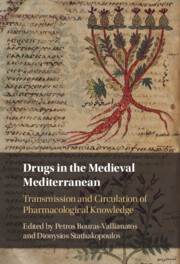Book contents
Medieval Mediterranean Pharmacology
Published online by Cambridge University Press: 19 October 2023
Summary
This chapter introduces the contents of this volume and provides a critical overview of medieval pharmacology with a focus on the Mediterranean from the ninth/tenth century to the fifteenth. It emphasises the importance of drawing evidence from various cultures (Byzantine, Islamicate, Jewish, Latin) and disciplines (history, art history, manuscript studies, and archaeology) in order to discuss topics of broader significance for the global Middle Ages, such as the transfer of medical and pharmacological knowledge. It also shows how our understanding of medieval pharmacology can be significantly expanded by the study of evidence from other areas, such as alchemy, cooking, diplomacy, magic, religion, and philosophy.
Keywords
- Type
- Chapter
- Information
- Drugs in the Medieval MediterraneanTransmission and Circulation of Pharmacological Knowledge, pp. 1 - 34Publisher: Cambridge University PressPrint publication year: 2023

